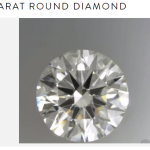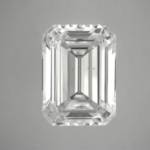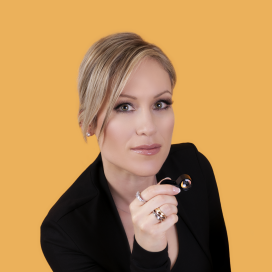Diamonds For Beginners – 8 Simple Steps To Get You Started
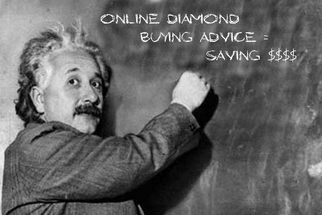 When it comes time to start shopping for an engagement ring, many men find diamonds intimidating. This diamonds for beginners check-list will help any new diamond buyer understand where to start and how to buy a diamond like pro.
When it comes time to start shopping for an engagement ring, many men find diamonds intimidating. This diamonds for beginners check-list will help any new diamond buyer understand where to start and how to buy a diamond like pro.
1. Before you start on your quest to understanding diamonds, you’ll first need to find out what your available budget is.
It doesn’t matter whether you have saved cash or intend on financing your engagement ring, you will still need to find out what your realistic budget is. The diamond industry advises 1-2 months salary, but of course this is a personal decision and really depends on what you can afford.
Determining your budget is a crucial first step because it will help to determine other factors towards your engagement ring purchase. For example, this is the first question that I always ask when readers contact me because this gives me an indication of what color and clarity characteristics I can work with to maximize your carat weight for your given budget.
2. Find out what diamond shape your soon-to-be-fiance likes.
If she hasn’t mentioned what she wants, then perhaps you can ask her family or friends for hints and tips on what to get her. If you are still clueless and want to keep your engagement a secret from everyone, then most men choose either a traditional round brilliant diamond or princess cut diamond as these are the two most popular shapes. For the more adventurous, another popular diamond shape is the cushion cut diamond shape. Overall, this should be a fairly simple decision that you may already have an answer for.
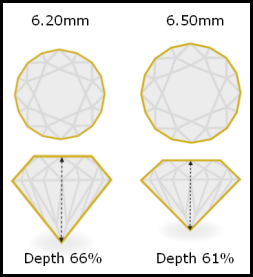
1 carat diamond with different cut proportions. Notice the diamond on the right has a larger table, which makes it visually BIGGER than the diamond on the left.
3. With regard to a diamond’s carat weight, you want to ensure that your diamond is proportioned correctly.
For example, you do not want a round brilliant diamond that is cut too steep/deep. “Steep/Deep” is an industry term for diamonds that carry more carat weight in the pavilion or lower half of the diamond. Many diamond cutters cut diamonds for weight rather than beauty. This is because they can get more money for a higher carat weight diamond. However, smart diamond buyers know that the best diamonds are well proportioned, no matter which shape they are.
Carat weight has the biggest influence on a diamond’s price. Therefore, if a diamond is cut to carry more carat weight in the pavilion, although it may be a 1.00ct diamond, the diameter of the crown portion (top) of the diamond may actually be smaller than a correctly proportioned “ideal” cut diamond.
To illustrate this point, consider that it is very common to come across a 1.00ct “ideal” cut diamond that looks visually BIGGER than a 1.00ct “good” cut diamond. This is because the ideal cut diamond has a diameter of 6.5mm while the “good” cut has a diameter of only 6.2mm. Due to their cut, their visual size appears either smaller or larger.
4. When it comes to a diamond’s cut, always go for an Ideal or excellent cut stone.
These diamonds are cut to a precise mathematical formula that ensures each facet is in proportion to one another. Ideal and excellent cut stones reflect back the most light and look more visually appealing. This goes for all diamond shapes, though the most popular and easiest to purchase are round brilliant and princess cut diamonds.
Keep in mind that a diamond’s cut directly influences it’s “sparkle” and brilliance (light that is reflected back to you visually). A poor cut stone will look dark and dead with no personality. Cut is by far the most important “C”, so it is best that you invest your money in this characteristic.
Unfortunately, most online diamond retailers are still selling diamonds with very little information. They have no magnified pictures, no light reflector technology (ASET or ideal-scope images), no videos, etc. This is because most diamond websites do not own any of their diamonds, and instead just post a virtual list of diamonds that are actually owned by other wholesalers.
(Pro Tip: If you are looking for the easiest way to buy a round ideal cut diamond, check out Whiteflash and be sure to check the ‘in house’ diamonds box. For more info, check out my Whiteflash review.)
5. You just need to buy a diamond that is “eye-clean”, in other words a diamond that has no visible inclusions to the naked eye.
Diamond clarity refers to the number and size of tiny imperfections that occur in nearly all diamonds. The imperfections can occur on the surface of the diamond (blemish) or within the diamond (inclusion) itself.
You do not need to purchase a flawless diamond to ensure that it is beautiful or brilliant; remember the CUT of a diamond is what makes a diamond brilliant. The best diamond retailers supply 20x’s magnified pictures of each diamond in their inventory with a “virtual loop” to see what inclusions are in each diamond.
Check out my video below to see how I go about evaluating eye-clean clarity in diamonds:
(Pro Tip: ODBA’s diamond search allows you to search through multiple diamond retailers and their diamond images all at once!)
6. Assuming that you are looking for round brilliant diamond, you would be perfectly fine to look for a diamond that is H, I, or J in color (for white gold/platinum settings) or K – M color for yellow gold settings.
Diamond’s are graded on their lack of color and the most expensive diamonds in this category are the colorless diamonds (D, E, and F) and then the near colorless, (G, H, I, and J) continuing down the alphabet until you get to Z.
Diamond color is a rarity characteristic and not necessarily associated with beauty which means you can save a lot of money by purchasing a diamond that has a lower color grade. Other diamond shapes can retain color more than others, so if you are looking to save money on a fancy shaped diamond (anything other than round brilliant) then please contact me for more info.
(Pro Tip: Cape diamonds are offered at significantly lower prices and consumers can take advantage of getting a larger hearts and arrows diamond for a fraction of the price.)
7. To keep things safe and simple, it is best to stick with either the Gemological Institute of America (GIA) or the American Gemological Society (AGS) for a diamond certificate.
These two labs are the most consistent in their grading and stick to similar quality standards. Other laboratories like IGI, EGL, and HRD have been found to show greater inconsistencies across the board and generally are not reliable.
8. You will find the best deals for diamonds online because they don’t have the overhead that would result in a significant diamond mark-up to the consumer.
Other great advantages to purchasing your engagement ring online, is that many online diamond retailers are staying competitive by offering a) 3rd party appraisals b) 30 day money back guarantees and 3) life-time upgrade policies.
In Conclusion
When it comes to buying a diamond most people want to make sure that they do their homework to ensure everyone is happy. This ‘Diamonds For Beginners’ is a great way to start your diamond search and gain some helpful insight into the diamond buying process. If you’d like some diamond recommendations and advice please be sure contact me. I look forward to working with you!
Happy Diamond Buying! 😉
Hey.You Want Ideal Cut Diamonds?
You've got it.
Join ODBA's Diamond Deal Friday and get handpicked diamonds every week from me to you.
No consultation required. Subscribe now!
ODBA Recommends
You May Also Like



